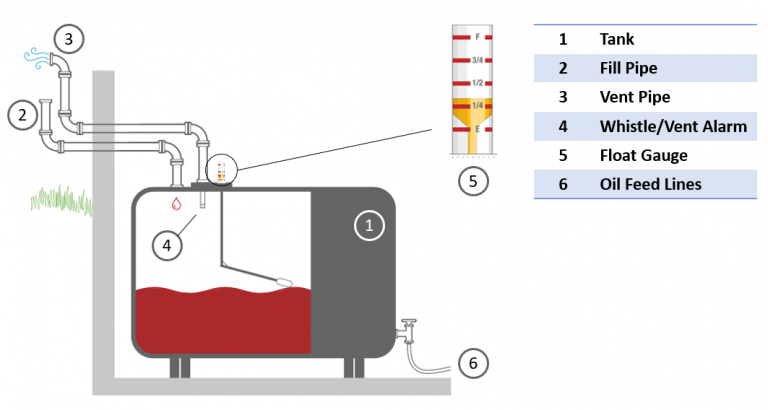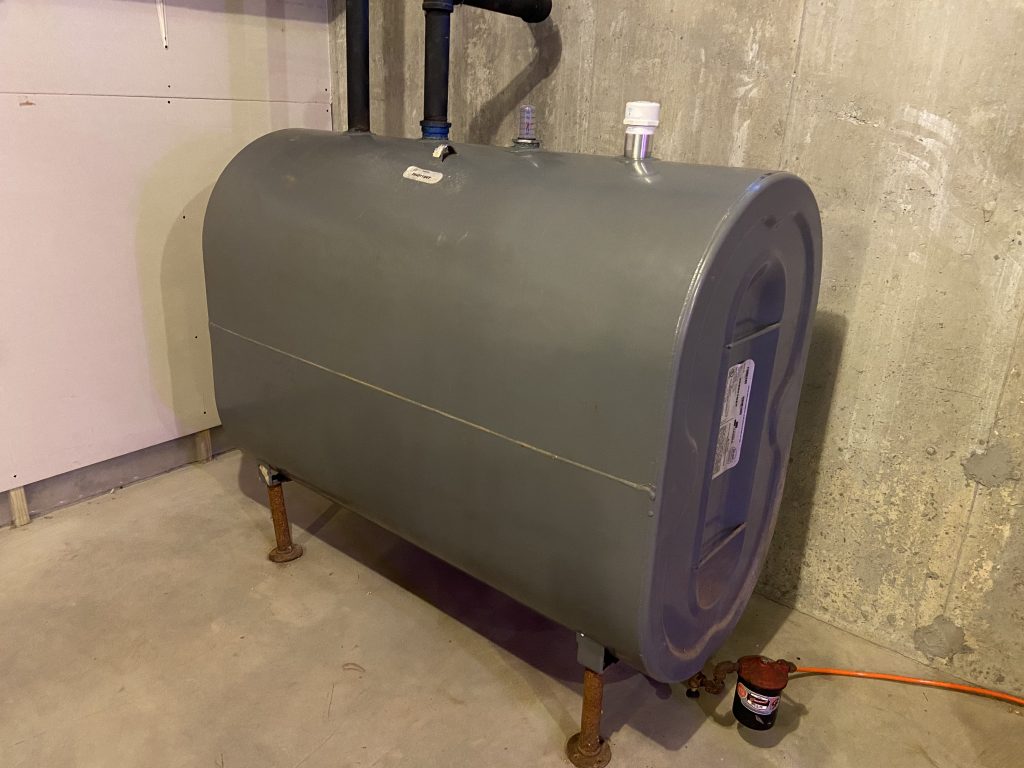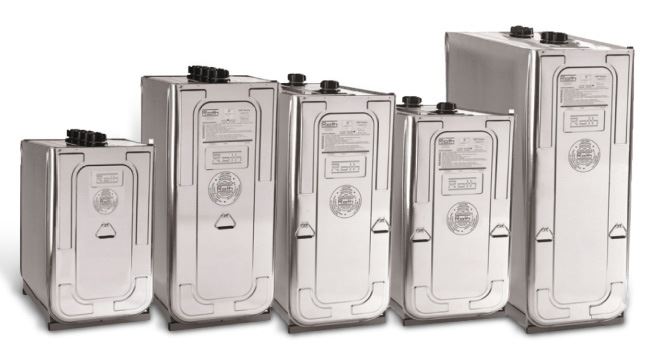It’s summer time! This means its the perfect opportunity to consider some HVAC maintenance. Getting your A/C and heating systems serviced during this time is a smart idea, because this time of year is considered to be off season. This is when dealers and HVAC technicians have more time and availability due to less of a demand for heating oil. Due to this increased availability, it’s the perfect time to replace your heating oil tank!
With a standard lifespan of anywhere from 10-30 years, most tanks will need to be replaced after thirty years or so. However, if you properly maintain your tank, it will last even longer!
In this post, we will go through the process of selecting a new home heating oil tank! This article will cover two popular tank styles, Granby steel tanks and Roth Double-Wall tanks.
How does a Fuel Oil Tank work?
Before selecting a new tank, it is vital to understand how a heating oil tank works. Firstly, when the delivery takes place, the driver will access your tanks fill pipe that is usually located outside your home. There is also a vent pipe that is located close to the fill pipe. The vent pipe allows air to enter the tank as you use oil and exit the tank as you receive oil. This is used mostly to alleviate pressure from the tank as it is being filled. Attached to the bottom of the vent is a whistle. The whistle notifies the driver when to stop pumping oil into the tank to avoid overfill. The whistle will continue to make a sound until oil covers it. Once the oil has covered the whistle, the driver will stop pumping. If you are curious on the filling process, please check out this article!

Each heating oil tank comes with a float gauge. This is a vital part of your tank, and it is very important to have a functioning whistle. We will discuss the gauge in a bit more detail below.
Finally, your tank comes equipped with feed lines. These are usually located on either the top or bottom of the tank. They feed the burner which will then supply heat to the rest of your home. One thing to be aware of with the feed lines, is that if they are on the top of the tank, the lines will not reach down to the bottom. This will typically leave a few gallons of oil sitting at the bottom of the tank. With these few gallons at the bottom of the tank, you will never run out of oil. However, you will simply reach the limit of oil accessible to your feed lines.
Granby Steel Tanks
These tanks are easily the most common tank choices. They come in a large variety of sizes, but you will often see them as 275 or 300 gallon tanks.
Granby tanks will often have four openings on the top, they also include several openings on the bottom for possible feedline locations. The benefit to have four fittings on the top is that you can install both the Float Gauge AND the Smart Oil Gauge side by side each other. This will give you the ability to measure your oil level from both the tank location and remotely on your phone, wherever you go!

Granby offers many different tanks at many different sizes. Their tank sizes range from 138 gallons to 330 gallons. In most cases, their tanks are also only available in either a vertical or horizontal orientation. Those orientations are designed to be able to fit in crawl spaces and tight spaces. If your home already has a Granby tank, then it is easier to simply replace the preexisting Granby tank with a new one. This is because there will already be enough space for the tank. Additionally, the fill pipe and vent pipe will already line up with the new tank.
Additionally, with Granby tanks, you will be able to easily add multiple tanks to your existing one. However, this will only be possible if you have enough room for those additional tanks. All the technician has to do, is add some additional components onto both tanks to connect them. Having multiple tanks will increase your overall oil capacity. This will let you order more oil in larger amounts! Be sure to checkout our FuelSnap website for the best oil prices!
Using a Smart Oil Gauge on a Granby Tank
Granby tanks are the most common tank that we see the Smart Oil Gauge installed onto. They have exactly two inch fittings that the smart oil gauge can be screwed into. With the Smart Oil Gauge installed onto your tank, you will know the precise reading of oil in your tank.
Additionally, the gauge will track your usage data! It is constantly keeping track of oil consumption throughout the days, weeks, months and years! With this added information, you’ll be able to conserve more heating oil by setting your thermostat to it’s optimal settings to coincide with the Smart Oil Gauge!
Roth Double-Wall Tanks

If you’re looking for a more modern look for your oil tank, then a Roth tank might be the style for you! The inside of a Roth tank features a plastic internal tank. This plastic tank is also surrounded by the exterior metal tank. The good thing about having a plastic tank, is that it will not corrode. However, other fuel tanks will corrode over time. With the inclusion of the metal exterior of the tank, if the plastic tank on the interior were to fail, the metal exterior will catch the contents of the plastic tank.
Compared to Granby tanks, Roth tanks have a smaller and more compact footprint. Additionally, they are lighter than the Grandby tank. This makes them much easier to maneuver into your basement or wherever you wish to install the tank. Despite that, most installers don’t have experience with Roth tanks and will often try to persuade you towards a Granby tank.
Roth tanks come equipped with four openings on the top of the tank. They are used for the fill pipe, vent pipe and feed lines. There is an extra fitting that you can use for whatever else you would like. However, you must choose carefully because there is only one extra fitting. This can include either a standard float gauge, or a Smart Oil Gauge.
Using a Smart Oil Gauge on a Roth Tank
Installing the Smart Oil Gauge onto a Roth tank is a little bit different from a Granby tank. First thing to note is that the gauge is not compatible with the Roth 1500L(400 Gallons). This is because that specific tank has a large support baffle in the middle of the tank that will interfere with the gauge’s readings.
An adapter is a requirement for installing the gauge onto the tank. Without the adapter, the gauge will always read as full. This is because the signal comes out of the gauge in a cone shape. Without the adapter, the signal will bounce off of the bottom threads of the tank’s fitting. This will result in the gauge always reading as full.
It’s also important to note that when setting up the Smart Oil Gauge on a Roth tank, that there’s a different installation method then on a standard steel tank. The Roth adapter is required for installation on these tanks. Additionally, the process in which you install it is different. You can watch our installation guide here.
Choosing Between a Granby and Roth Tank
In order to make your decision easier, we’ve come up with a helpful chart to show you the differences between the two tanks side by side. For the Roth tank, you should expect to pay a little bit more. This is because the Roth tank comes with a 30 year warranty included with it. While the Roth tank is also more lightweight and compact compared to the Granby tank, not all installers are familiar with the Roth Tanks.
However, if you like a a well built tank that is familiar to installers, Granby might be the way to go. You’ll also be able to easily add additional tanks to the Granby tank. So long as it fits within your budget. Doing so will allow you to order more heating oil when you need it! You’ll also be able to jump on discounted pricing with orders consisting of 200 or more gallons.

In conclusion, your personal preference will play a larger role in deciding which heating oil tank you will ultimately go with. The easiest method to changing your tank is to simply change the existing tank with the same type of tank. This will ultimately reduce labor costs and make the job easier for the HVAC technician. If you are interested in the smaller footprint or warranty, then purchasing a Roth tank might be the way to go. With the Granby tank, you will be able to use both your standard Float Gauge and the Smart Oil Gauge. The Smart Oil Gauge will help you keep track of your oil level and consumption, even if you aren’t home! Regardless of which tank you decide to go with, you should discuss the options with your HVAC technician and the individuals you live with.
Happy Heating,
Hunter



